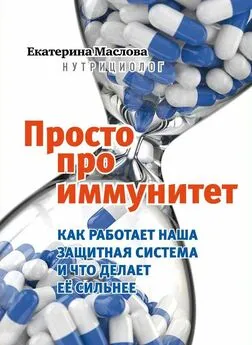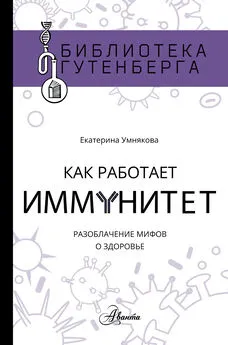Екатерина Умнякова - Как работает иммунитет [litres]
- Название:Как работает иммунитет [litres]
- Автор:
- Жанр:
- Издательство:Литагент АСТ
- Год:2019
- Город:М.
- ISBN:978-5-17-112323-9
- Рейтинг:
- Избранное:Добавить в избранное
-
Отзывы:
-
Ваша оценка:
Екатерина Умнякова - Как работает иммунитет [litres] краткое содержание
Для широкого круга читателей.
Как работает иммунитет [litres] - читать онлайн бесплатно ознакомительный отрывок
Интервал:
Закладка:
Govender T., Dawood A., Esterhuyse A.J., Katerere D.R. Antimicrobial properties of the skin secretions of frogs. // S Afr J Sci. 2012. Vol. 108, № 5/6. Art. 795.
Mashreghi M., Rezazade Bazaz M., Mahdavi Shahri M.N., Asoodeh A., Mashreghi M., Behnam Rassouli M., Golmohammadzadeh S. Topical effects of frog «Rana ridibunda» skin secretions on wound healing and reduction of wound microbial load. // J Ethnopharmacol. 2013. Vol.145, № 3. P. 793–797.
Church J.C. The traditional use of maggots in wound healing, and the development of larva therapy (biosurgery) in modern medicine. // J. Altern. Complement. Med. 1996. Vol. 2. P. 525–527.
Danihlík J., Aronstein K., Petřivalský M. Antimicrobial peptides: a key component of honey bee innate immunity. // Journal of Apicultural Research. 2015. Vol. 54, № 2. P. 123–136.
Casteels P., Ampe C., Jacobs F., Vaeck M., Tempst P. Apidaecins: antibacterial peptides from honeybees. // EMBO J. 1989. Vol. 8, № 8, P. 2387–2391
Flemming A. On a remarkable bacteriolytic element found in tissues and secretions. // Proceedings of the Royal Society B: Biological Sciences. 1922 Vol. 93, № 653. P. 306–317.
Flemming A. On the antibacterial action of cultures of penicillium, with special reference to their use in the isolation of B. infuenza. // Brit. J. Exper. Path. 1929. Vol. 10, P. 226.
Нельсон Д., Кокс М. Основы биохимии Ленинджера: в 3 т. Т. 1: Основы биохимии, строение и катализ. пер. с англ. – М.: Бином. Лаборатория знаний, 2012. – 694 с.
Jollès P. Lysozymes: model enzymes in biochemistry and biology. 1st edition. Birkhauser Verlag, Basel, 1996. – 469 pp.
Faurschou M., Borregaard N.Neutrophil granules and secretory vesicles in inflammation. // Microbes Infect. 2003. Vol. 5, № 14. P. 1317–1327.
Aratani Y. Myeloperoxidase: its role for host defense, inflammation, and neutrophil function. // Arch Biochem Biophys. 2018. Vol. 15, № 640. P. 47–52
Farnaud S., Evans R.W. Lactoferrin-a multifunctional protein with antimicrobial properties. // Mol Immunol. 2003. Vol. 40, № 7. P. 395–405.
Кокряков В.Н. Очерки о врожденном иммунитете. – СПб.: Наука, 2006 – 260 с.
Cotter P.D., R. Ross R.P., Hill C. Bacteriocins – a viable alternative to antibiotics? // Nat Rev Microbiol. 2013. Vol. 11. P. 95–105.
Zeya H.I., Spitznagel J.K. Antimicrobial specificity of leukocyte lysosomal cationic proteins // Science. 1966. Vol. 154, № 3752. P. 1049–1051.
Ganz T., Selsted M.E., Szklarek D., Harwig S.S., Daher K., Bainton D.F., Lehrer R.I. Defensins. Natural peptide antibiotics of human neutrophils. // J. Clin. Invest. 1985. V. 76, № 4. P. 1427–1435.
Phoenix D.A., Dennison S.R., Harris F. Antimicrobial peptides. Wiley-VCH Verlag GmbH & Co. KGaA, 2013, – 231 pp.
Zhang L. Antimicrobial peptides. / Zhang L., Gallo R.L // Current Biology. 2016. – V.26, – P. R1–R21.
Kang H.K., Kim C., Seo C.H., Park Y. The therapeutic applications of antimicrobial peptides (AMPs): a patent review. // J Microbiol. 2017. Vol. 55, № 1. P. 1–12.
Hoskin D.W., Ramamoorthy A. Studies on anticancer activities of antimicrobial peptides. // Biochim Biophys Acta. 2008. Vol. 1778, № 2. P. 357–375.
Roudi R., Syn N.L., Roudbary M. Antimicrobial peptides as biologic and immunotherapeutic agents against cancer: a comprehensive overview. // Front Immunol. 2017. Vol. 8. Article 1320.
Dinarello C.A. Historical review of cytokines. // Eur J Immunol. 2007. Vol. 37. Suppl 1. P. S34–S45.
Akdis M., Burgler S., Crameri R., Eiwegger T., Fujita H., Gomez E., Klunker S., Meyer N., O’Mahony L., Palomares O., Rhyner C., Ouaked N., Schaffartzik A., Van De Veen W., Zeller S., Zimmermann M., Akdis C.A. Interleukins, from 1 to 37, and interferon-γ: receptors, functions, and roles in diseases. // J Allergy Clin Immunol. 2011. Vol. 127, № 3. P. 701–721.
Parkin J., Cohen B. An overview of the immune system. // Lancet. 2001. Vol. 357, № 9270. P. 1777–1789.
Pestka S. The interferons: 50 years after their discovery, there is much more to learn. // Journal Biol Chem. 2007. Vol. 282, № 28. P. 20047-20051.
Baldo B.A. Side effects of cytokines approved for therapy. // Drug Saf. 2014. Vol. 37. P. 921–943
Mélik-Parsadaniantz S., Rostène W. Chemokines and neuromodulation. // Journal Neuroimmunol. 2008. Vol. 198, № 1–2. P. 62–68.
Chen K., Cerutti A. The function and regulation of immunoglobulin D. // Curr Opin Immunol. 2011. Vol. 23, № 3. P. 345–352.
Шенфельд И., Мерони П.Л., Чурилов Л.П… Руководство по аутоиммунным заболеваниям для врачей общей практики; пер. с англ. СПб.: Элби-СПб. 2017, – 416 с.
Rowley M.J., Whittingham S.F. The role of pathogenic autoantibodies in autoimmunity. // Antibodies. 2015. Vol. 4. P. 314–353
Chard T. Pregnancy tests: a review. // Hum Reprod. 1992. Vol. 7, № 5. P. 701–710.
Weiner L.M., Dhodapkar M.V., Ferrone S. Monoclonal antibodies for cancer immunotherapy. // Lancet. 2009. Vol. 373, № 9668. P. 1033–1040.
Weiner L.M., Murray J.C., Shuptrine C.W. Antibody-based immunotherapy of cancer: new insights, new targets. // Cell. 2012. Vol. 148, № 6. P. 1081–1084.
Catty D. Antibodies: a practical approach / D. Catty. – Oxford University Press, USA, – 1988. – 259 pp.
Ricklin D., Lambris J.D. Complement in immune and inflammatory disorders: pathophysiological mechanisms // J. Immunol. 2013. V. 190, № 8. P. 3831–3838.
Merle N.S., Noe R., Halbwachs-Mecarelli L., Fremeaux-Bacchi V., L.T. Roumenina L.T. Complement system part I – molecular mechanisms of activation and regulation. // Front Immunol. 2015.V.6. Article 262.
Merle N.S., Noe R., Halbwachs-Mecarelli L., Fremeaux-Bacchi V., L.T. Roumenina L.T. Complement system part II: Role in immunity // Front Immunol. 2015. V.6. Article 257.
Janeway C.A. Approaching the asymptote? Evolution and revolution in immunology. // Cold Spring Harb. Symp. Quant. Biol. 1989. Vol. 54, P. 1–13.
Park B.S., Lee J.-O. Recognition of lipopolysaccharide pattern by TLR4 complexes. // Exp Mol Med. 2013. Vol. 45, № 12. E66.
Поль де Крюи Охотники за микробами. СПб.: Амфора, 2015, – 352 с.
Brown K. The Penicillin Man. Sutton Publishing, London, 2004. 320pp.
Джессика Снейдер Сакс. «Микробы хорошие и плохие» М.: АСТ: CORPUS, 2014. – 496 c.
Thom C. Fungi in cheese ripening; Camembert and Roquefort. // U.S.D.A. Bureau of Animal Industry Bulletin. 1906. Vol. 82, P. 1–39
Vallone L., Giardini A., Soncini G. Secondary metabolites from Penicillium roqueforti, a starter for the production of gorgonzola cheese. // Ital J Food Saf. 2014. Vol. 3, № 3. P. 2118.
Larsen A.G., Knechel S. Antimicrobial activity of food-related Penicillium sp. against pathogenic bacteria in laboratory media and a cheese model system. // J Appl Microbiol. 1997. Vol. 83, № 1. P. 111–119.
Flemming A. On the antibacterial action of cultures of penicillium, with special reference to their use in the isolation of B. infuenzal. // Brit. J. Exper. Path. 1929. Vol. 10, P.226.
M. E. Florey, H. W. Flоrey. General and local administration of penicillin. // Lancet. 1943. Vol. 1. P. 387.;
Chain E., Florey H.W., Gardner A.D., Heatley N.G., Jennings M.A., Orr-Ewing J., Sanders A.G. Penicillin as a chemotherapeutic agent. // Lancet 1940; Vol. 2. P. 226–228).
Ермольева З.В., Пенициллин. М.: Медгиз. 1946. – 159 с.
Burmeister A.R. Horizontal gene transfer. // Evol Med Public Health. 2015. Vol. 2015, № 1. P. 193–194.
Jing Li, Junji Cao, Yong-guan Zhu, Qing-lin Chen, Fangxia Shen, Yan Wu, Siyu Xu, Hanqing Fan, Guillaume Da, Ru-jin Huang, Jing Wang, Alma Lorelei de Jesus, Lidia Morawska, Chak K. Chan, Jordan Peccia, and Maosheng Yao. Global survey of antibiotic resistance genes in air // Environmental Science & Technology, 2018, Vol. 52, № 19, p. 10975—10984
Грин Н., Стаут У., Тейлор Д. Биология. 10 изд. в 3-х томах. – Издательство: Бином. Лаборатория знаний, 2018. – 1340 c.
Hymes K.B., Cheung T., Greene J.B., Prose N.S., Marcus A., Ballard H., William D.C., Laubenstein L.J. Kaposi’s sarcoma in homosexual men-a report of eight cases. // Lancet. 1981. Vol. 2, № 8247. P. 598–600.
Centers for Disease Control (CDC). Kaposi’s sarcoma and Pneumocystis pneumonia among homosexual men – New York City and California. // MMWR Morb Mortal Wkly Rep. 1981. Vol. 30, № 25. P. 305–308.
Schloss P.D., Handelsman J. Status of the microbial census. // Microbiol Mol Biol Rev. 2004. Vol. 68, № 4. P. 686–691.
Sender R., Fuchs S., Milo R. Revised estimates for the number of human and bacteria cells in the body. // PLoS Biol. 2016. Vol.14, № 8. e1002533.
Galland L. The gut microbiome and the brain. // J Med Food. 2014. Vol.17, № 12. P. 1261–1272.
Roberts E., Lowe I. P., Guth L., Jelinek B. Distribution of γ-aminobutyric acid and other amino acids in nervous tissue of various species. // J. Exp. Zool. 1958. Vol. 138, P. 313–328.
Kuriyama K., Sze P. Y. Blood – brain barrier to h3-γ-aminobutyric acid in normal and amino oxyacetic acid-treated animals. // Neuropharmacology 1971. Vol. 10, P.103–108.
Van Gelder N. M., Elliott K. A. C. Disposition of γ-aminobutyric acid administered to mammals. // J. Neurochem. Vol. 3. P. 139–143.
Knudsen G. M., Poulsen H. E., Paulson O. B. Blood – brain barrier permeability in galactosamine-induced hepatic encephalopathy. // J. Hepatol. 1988. Vol. 6. P. 187–192.
Takanaga H., Ohtsuki S., Hosoya K., Terasaki T. GAT2/BGT-1 as a system responsible for the transport of γ-aminobutyric acid at the Mouse Blood – Brain Barrier. // J. Cereb. Blood Flow Metab. 2001. Vol. 21. P. 1232–1239
Kakee A., Takanaga H., Terasaki T., Naito M., Tsuruo T., Sugiyama Y. Efflux of a suppressive neurotransmitter, GABA, across the blood – brain barrier. // J. Neurochem. 2001. Vol. 79. P. 110–118.
Boonstra E., Roy de Kleijn R., Colzato L.S., Alkemade A., Forstmann B.U., Nieuwenhuis S. Neurotransmitters as food supplements: the effects of GABA on brain and behavior. // Front Psychol. 2015. Vol. 6. Article 1520.
Cardoso M.S., Reis-Cunha J.L., Bartholomeu D.C. Evasion of the immune response by Trypanosoma cruzi during acute infection // Front Immunol. 2015. Vol. 6, P. 659
Maizels R.M., McSorley H.J. Regulation of the host immune system by helminth parasites. // J Allergy Clin Immunol. 2016. Vol. 138, № 3. P. 666–675.
Mahanty S., Mollis S.N., Ravichandran M., Abrams J.S., Kumaraswami V., Jayaraman K., Ottesen E.A., Nutman T.B. High levels of spontaneous and parasite antigen-driven interleukin-10 production are associated with antigen-specific hyporesponsiveness in human lymphatic filariasis // J Infect Dis. 1996. Vol. 173, № 3. P. 769–773.
Smallwood T.B., Giacomin P.R., Loukas A., Mulvenna J.P., Clark R.J., Miles J.J. Helminth immunomodulation in autoimmune disease. // Front Immunol. 2017. Vol. 8. Article 453.
Tang D., Rui Kang R., Coyne C.B., Zeh H.J., Lotze M.T. PAMPs and DAMPs: Signal 0s that Spur Autophagy and Immunity. // Immunol Rev. 2012. Vol. 249, № 1. P. 158–175.
Candeias S.M., Gaipl U.S. The immune system in cancer prevention, development and therapy. // Anticancer Agents Med Chem. 2016. Vol.16, № 1. P. 101–107.
Читать дальшеИнтервал:
Закладка:
![Обложка книги Екатерина Умнякова - Как работает иммунитет [litres]](/books/1082598/ekaterina-umnyakova-kak-rabotaet-immunitet-litres.webp)
![Екатерина Мекачима - За тридевять земель [litres]](/books/1056641/ekaterina-mekachima-za-tridevyat-zemel-litres.webp)
![Екатерина Васина - Да, детка, это – реальность! [litres]](/books/1057960/ekaterina-vasina-da-detka-eto-realnost-lit.webp)
![Екатерина Урузбиева - Охота на Тени [litres]](/books/1062038/ekaterina-uruzbieva-ohota-na-teni-litres.webp)
![Екатерина Флат - В погоне за тайной [litres]](/books/1063073/ekaterina-flat-v-pogone-za-tajnoj-litres.webp)
![Екатерина Рождественская - Балкон на Кутузовском [litres]](/books/1064280/ekaterina-rozhdestvenskaya-balkon-na-kutuzovskom-li.webp)
![Екатерина Звонцова - Серебряная клятва [litres]](/books/1064926/ekaterina-zvoncova-serebryanaya-klyatva-litres.webp)
![Екатерина Елизарова - Хранительница дракона [litres]](/books/1066933/ekaterina-elizarova-hranitelnica-drakona-litres.webp)
![Екатерина Соболь - Призрачный сыщик [litres]](/books/1143957/ekaterina-sobol-prizrachnyj-sychik-litres.webp)

